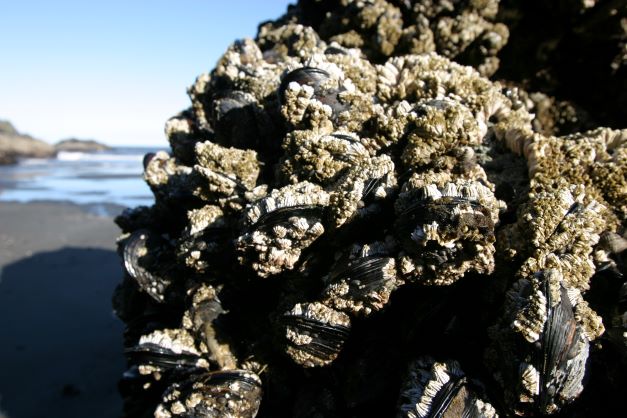Looking for a special culinary experience while visiting the Oregon Coast? Head for areas of exposed tidal rocks in search of a seldom-heralded seafood delicacy—mussels.
STORY BY GRACE ELTING CASTLE
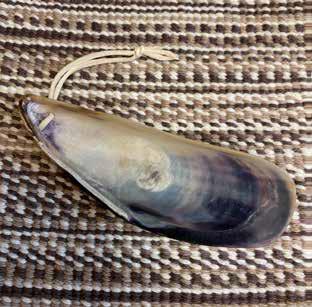
Mussels have been a staple in the diet of coastal Natives probably from the beginning of time. The shells of these bivalve mollusks were saved for special uses such as a spoon. Even when the agent at the Siletz Indian Reservation forbid the dance known as Nee Dosh, and in the 1870s ordered all six dance houses on the reservation burned to the ground, the beautiful shells adorning the Nee Dosh regalia were treasured and protected by the People.
Years later, in the mid-1990s, when the tribe was striving to bring back the traditional Nee Dosh and building a dance house overlooking the river in Siletz, Oregon, then culture directors Selene Rilatos and Robert Kentta traveled to New York to review a collection of Siletz tribal regalia. Eager to support the tribe’s efforts to restore traditions, the National Museum of Indians’ staff at the Bronx facility decided, for the first time ever, to loan six pieces to be danced in the new Siletz Dance House. One of the six delicate and beautiful pieces was a mussel shell necklace.
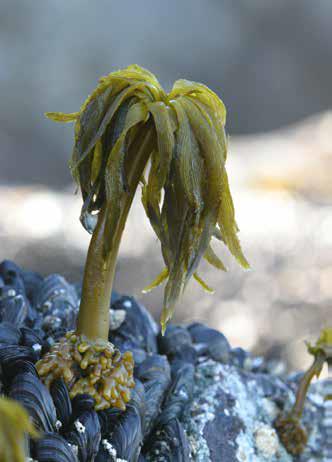
OREGON COAST MUSSELS
There are bay mussels (Mytilus edulis) and California surf mussels (Mytilus californianus) here. Bay mussels have a bluish black shell that only grows to about 3 inches while the surf mussels are larger with brown or black shells that grow to a length of 7 inches.
Mussels are eaten by folks around the world and by starfish, seabirds, and predatory marine gastropods like the snail-like whelk. Internationally, the mussels are prepared in an endless variety of recipes ranging from steaming and then dipping the bright orange meat in melted butter, to barbecuing, or adding to salads, soups, and chowders. Parts of the mussel have been scientifically tested to develop useful items including bonding agents, glues, and artificial tendons.
PREPARING FOR THE ADVENTURE
Proper preparation ensures personal safety and successful harvesting.
➤Determine what areas are open to mussel gathering by calling the Shellfish Safety Hotline (800-448-2474) or checking the ODA website at oregon.gov/oda/programs/FoodSafety/Shellfish/Pages/ShellfishClosures.aspx and oregon.gov/oda/shared/Documents/Publications/FoodSafety/CurrentBiotoxinData.pdf
➤Be sure to make note if any of the sites you are considering are printed in red letters as that denotes the area is closed due to toxins that cause paralytic shellfish poisoning that could cause paralysis or death!
➤Check sporting goods stores and large department stores with sports sections for the state booklet showing approved, open areas for mussel gathering.
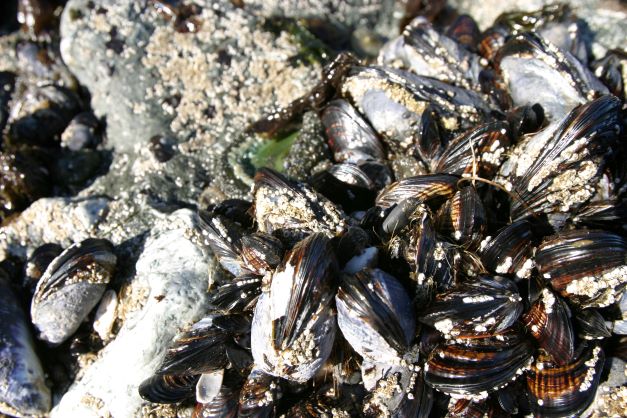
➤Special marine protection areas are off limits for gathering mussels: Otter Rock, Cape Kiwanda, Yaquina Head, and Yachats.
➤Obtain a shellfish license for each participant 12 and older. Licenses are available at sporting stores and some grocery stores. An annual license for Oregon residents is $7. For non-Oregon residents $20.50, or $11.50 for a three-day license.
➤Obtain a tide table book from almost any business and determine when the lowest tides will be so you can safely access the beach and get your limit of mussels before the next tide.
WHAT TO WEAR AND WHAT TO TAKE WITH YOU
There are no fashion police patrolling Oregon beaches so dress for warmth and safety. Wear old shoes that you don’t mind getting wet or dirty, that have good traction for the slippery rocks and sand, and that will protect your feet from sharp barnacles. Never wear open-toed shoes or go barefooted harvesting mussels.
Wear old clothes: shirt, long pants, jacket to protect from the cold wind and from getting cuts and scrapes on the rocks or from those pesky barnacles clinging to the mussel shells. Bring heavy gloves, and perhaps a sturdy knife or tool to help remove the mussels from the rocks. Also, you will need a bucket, basket, or bag for each person’s limit.
AND NOW TO GET THE MUSSELS OFF THE ROCKS
Mussels attach themselves to the boulders along the upper edges of Oregon’s central coast beaches and south to the California border, by using their byssal threads (commonly called a beard).
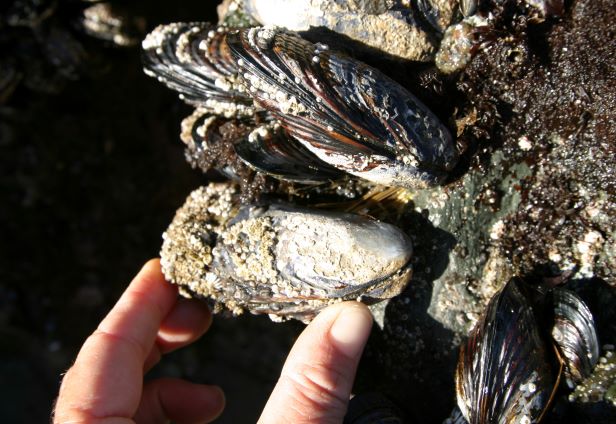
Usually the mussel can be removed by grasping the shell with a gloved hand and twisting it from the rock. Sometimes it may be necessary to use the knife or garden tool you brought along. Don’t smash the shell or the mussel will die and be inedible.
Do not put water in the bucket you will carry the muscles home in. They have to be able to breathe.
Wipe off as much of the sand clinging to the shells as possible.
Pull off the beard and discard. (If it is too difficult to remove, wait until you have boiled the mussels and the task should be easier).
The daily limit is 72 of any size, per person, year around.
Take only what you will use.
CLEANING TIPS
It is important to clean your bounty of mussels soon after gathering them. Put them in cold water and begin removing the remaining sand. A strong brush is useful in removing the sand and getting into the grooves of the larger shells.
Toss any mussels that are in opened shells. Extra heavy shells may be packed with sand rather than a mussel.
TIME TO EAT!
If you are not traveling in your own RV or camping in a tent spot, make sure you have permission to cook the mussels in your rental space or friend’s home. Cooked seafood has a distinctive aroma that is not appreciated by everyone.
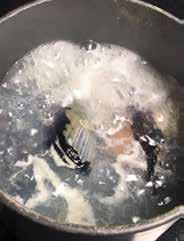
The easiest way to prepare mussels is to place them in boiling water in a covered pot. Reduce the heat so that they are not boiling violently. Stir occasionally. Check after three minutes. If shells are wide open, remove them from the heat and water. (I prefer to steam using white wine rather than boiling them, but that is often too difficult to accomplish while traveling).
There are muscles holding the mussels to the rocks and within the shell that you won’t want to eat as they are too chewy. No need to clean the stomachs from the mussels, either. Remove mussels from the shells, dip in melted butter and enjoy.
RECIPE: MUSSEL CHOWDER
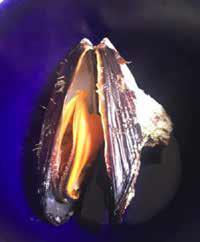
There are as many recipes for seafood chowders as there are mussels on coastal rocks, but one thing holds true for all true connoisseurs of seafood—always serve it with a wonderful bread!
Based on a clam chowder recipe in the James Beard Cookbook, E.P Dutton & Co., Inc. New York, 1961
- About 2 cups of chopped mussels
- 3 or four slices of salt pork (bacon) cut into cubes
- 2 medium potatoes, peeled and diced
- 1 small onion, peeled and chopped
- Salt and pepper
- 2 cups light cream
- Pinch of thyme
- Paprika
Using your freshly cleaned mussels, chop them or put them through a coarse grinder, being sure to save all the liquor. Fry the salt pork or bacon and cook the potato in salted boiling water until soft. When the salt pork or bacon is brown, remove it from the pan and sauté the chopped onion in the fat. Drain the cooked potatoes but save the potato water and return it to the stove to cook down a bit. Combine the salt pork (or bacon), the sautéed onion, the cooked potatoes, the potato water, the liquor from the mussels and the chopped raw mussels. Bring them to a boil, lower the heat and simmer gently for 5 to 10 minutes. Season to taste with salt and pepper and add the cream slowly.
Heat the soup gently just to the boiling point but do not let it boil. Stir in a tiny pinch of thyme just before you dish it up and dust the top of each bowl with a dab of butter and a little paprika.
This story appeared in the Fall–Winter 2020 issue of Oregon Coast magazine.

